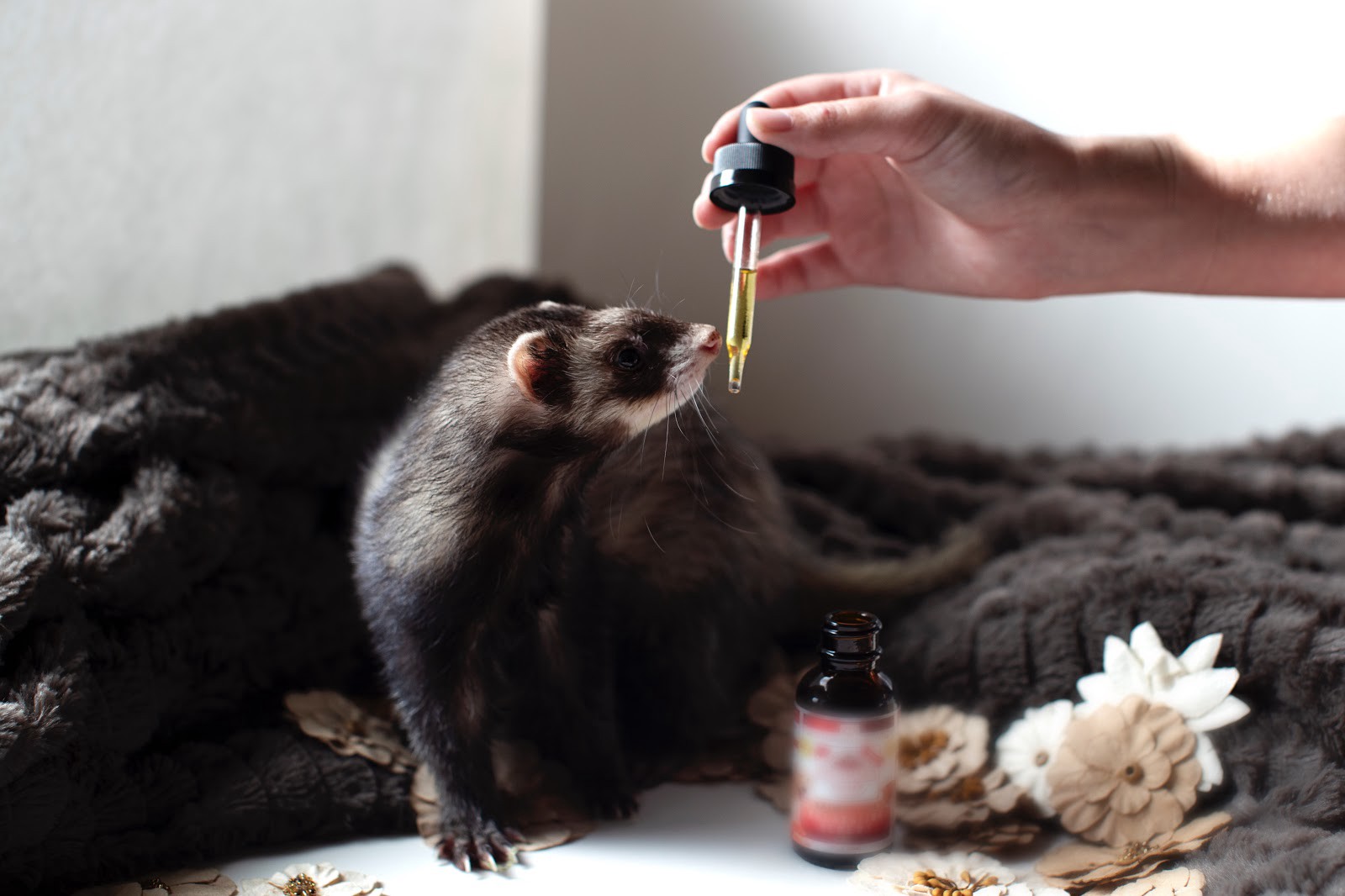
On September 14, 2018, Veterinary Medicines Directorate (VMD) in the UK published a statement on medicinal products containing Cannabidiol. According to the report, veterinary products containing CBD are medicines and should be regulated as such.
In this article, we decided to shed some light on CBD usage for animals: treatment of health conditions, dosage, and the effects of various product forms.
What is CBD?
CBD (Cannabidiol) is a derivative from the plant Cannabis Sativa. Unlike another derivative THC (Tetrahydrocannabinol), CBD has no psychoactive effects on the human or animal body and doesn?t cause a substantial impact on cognitive brain activity. Instead, this naturally occurring chemical compound can promote stress relief and relaxation effect on the brain and body. That?s why it is used in oils and edibles.
CBD and THC have the same molecular structure: 21 carbon atoms, 30 hydrogen atoms, and two oxygen atoms. Yet, there is a slight difference in how the atoms are arranged which determines the effect on the brain.

THC

CBD
CBD can be extracted from two cannabis species: marijuana and hemp. Hemp plants contain less than 0.3% THC, hence why they are the sources of CBD products for animals.
Why does CBD oil work for animals?
Every living being with a spinal column has the Endocannabinoid System (ECS), which evolved 600 million years ago. The system was discovered in the 1990s and initially considered to be present only in the brain and nerves. In 2008, the scientists from the Department of Psychological and Brain Sciences, Indiana University, Bloomington discovered cannabinoid receptors throughout the body, including our skin, immune cells, fat tissue, bone, liver, pancreas, skeletal muscle, kidneys, heart, blood vessels, and gastrointestinal tract.
Endocannabinoids are one of the most versatile signalling molecules known to this day. The ECS creates homeostasis within the body as it is involved in a wide range of processes, including pain, memory, mood, appetite, stress, metabolism, sleep, immune and reproductive functions. When the system is dysfunctional or damaged, it triggers a whole spectrum of disorders and diseases ? for example, anxiety, stress, inflammation, nausea, arthritis, epilepsy, and cancer.
CBD and THC have a chemical structure similar to your body?s own ECS, which allows them to interact with your cannabinoid receptors.
 Get your personalised CBD selection
Get your personalised CBD selection
Endocannabinoid System in animals: how does it work?
According to several studies, the ECS is present in the species other than humans, even such primitive creatures as sea squirts and flatworms. In 2012, the University of Pisa conducted a study on dogs. It was found that Cannabinoid receptors of two types are present in the skin of both healthy dogs and those with atopic dermatitis. Another study dates back to 2018. The University of Veterinary Medicine in Hannover concluded that the ECS is involved in immunomodulation. Regardless of species, the endocannabinoid system has three essential components:
- Metabolic enzymes
- Cannabinoid receptors
- Endocannabinoids
Metabolic enzymes FAAH (Fatty Acid Amide Hydrolase) and MAGL (Monoacylglycerol Lipase) have two purposes: accelerate endocannabinoid synthesis and break them down once they?ve served their purpose. ECS mechanism is different to neurotransmission and hormonal processes. It quickly releases enzymes and stops the action of cannabinoids. Neurotransmitters and hormones, in their turn, can both remain active and be stored in the body.
Cannabinoid receptors rest in cell membranes spread throughout the body. We can compare them to a car ignition which influences a whole range of functions in the body: pain perception, immune system, mood, sleep, and neurogenesis.
So far, we know two kinds of receptors: CB1 and CB2. CB1 receptors are found in the brain and spinal cord and are related to the central nervous system. CB2 receptors are embedded in peripheral tissues and majorly affect inflammatory processes, immune and digestive systems.
Endocannabinoids are fat-like molecules produced by our bodies that interact with cannabinoid receptors and activate them. Endocannabinoids is a subtype of cannabinoids which also include phytocannabinoids.

There are two types of cannabinoids: endogenous (endocannabinoids) and phytocannabinoids.
Endocannabinoids (e.g., Anandamide and 2-arachidonoylglycerol (2AG)) are synthesised when the body needs to maintain balance, and are degraded by metabolic enzymes afterwards.
Unfortunately, such a complex system as the ECS can falter, which leads to Clinical Endocannabinoid Deficiency (CECD). This condition contributes to the progression of illnesses and other dysfunctions, such as migraines, irritable bowel syndrome, and fibromyalgia.
Also, ECS dysfunction causes confusion on a molecular level. When metabolic enzymes fail to release or release incorrectly, endocannabinoids start to target inappropriate cells or deactivate ineffectively.
In this case, we can introduce cannabinoids derived from plants (phytocannabinoids) and restore homeostasis. Phytocannabinoids are usually extracted from Cannabis Sativa and include the following components:
- CBD (cannabidiol)
- THC (tetrahydrocannabinol)
- CBC (cannabichromene)
- CBL (cannabicyclol)
- CBN (cannabinol)
THC vs CBD
THC and CBD are the most abundant ones. Despite their similar chemical structures, the psychoactive effects of these phytocannabinoids are different.
THC binds with CB1 receptors in the brain, which produces a high or sense of euphoria. Other side effects include increased heart rate, coordination problems, red eyes, dry mouth, slower reaction, and memory loss. High amounts of THC may cause long-term adverse psychiatric effects.
CBD is considered safe for animal treatment as it doesn?t bind to CB1 receptors and can?t act on the brain. Hemp-derived CBD oil is absorbed into your pet?s bloodstream and starts to regulate its physiological processes. This phytocannabinoid is usually well-tolerated even in large doses CBD. In 2017, WHO has conducted research which suggests that any side effects occurring as a result of CBD use are likely to be caused by drug-to-drug interactions between CBD and other medications a person or animal might be taking.
How CBD helps in animal treatment

The list of conditions that can be alleviated by the inclusion of CBD into the treatment process is not definitive yet. In this article, we will focus on the most investigated health problems.
Anxiety
You may notice that your pet is terrified of toys, gets nervous when you leave, or hides from everyone in the house. If this behaviour is typical, it?s a clear sign of anxiety.
We can distinguish situational and behavioural anxieties.
Situational anxiety occurs when your pet reacts to immediate triggers like strangers, another dog?s barking or fireworks.
Behavioural anxiety is triggered by past experiences. For example, an animal can remember separation from the previous owner or cruel treatment. This type of anxiety is more complex and includes several subtypes: separation, rescue/ former shelter, illness-induced, and general (generalised) anxiety.
- Separation anxiety. Symptoms may occur when the people an animal is attached to leave him or her for some time. Such animals become upset and often agitated as they don?t know if that person will return.
- Rescue/ former shelter anxiety happens when pets have memories of being abandoned and spending time in shelters.
- Illness-induced anxiety is caused by a range of conditions. They include thyrotoxicosis, hypothyroidism, encephalitis, pre-diabetes, and vision or hearing loss.
- General anxiety encompasses the cases when the cause for anxiety can?t be clearly determined. Symptoms can be subtle and treated as normal behaviour. For example, some pet owners describe their furry friend as consistently ?frightened?, ?miserable? or ?never happy?. These pets don?t demonstrate exacerbated signs of fear in specific contexts but exhibit low energy levels indicative of anxiety most of the time. If you notice that excessive anxiety or apprehensive expectation last for at least six months, your pet needs to see a veterinarian.
Anxiety signs
Anxiety manifests itself through body language and unusual or destructive behaviour. Here are some examples of anxiety signals.
Shaking or trembling
The animal body can react by shaking in different situations, from being cold to having a kidney disease. Yet, tense muscles and, as a result, shaking can well be also attributed to separation anxiety in pets.
Reluctance to go outdoors
If your pet doesn?t want to go outdoors, it means something has happened that caused unpleasant emotions or fear. For example, it was attacked by another animal or stepped on something sharp, which caused pain.
Urination or defecation in inappropriate places
Episodes of anxiety can be followed by bouts of diarrhoea or urination. It is especially evident if your pet is well-trained and always does its business in appropriate places.
Whining or barking
When your pet whines or barks a lot, it can be treated as a signal of inability to relax and calm down. It often happens when animals are bored or feel lonely.
Excessive licking or salivating
Too much stimulation leads to excessive production of saliva. This often happens when animals are in a panic or feel like they are in a harmful situation.
Infections
Cats? infections
Our cats are exposed to pathogenic bacteria daily. Most of the time, their immune system is able to resist infection. When the immune system is weak, bacteria find a way to replicate and spread in the cat?s body.
Common types of pathogenic bacteria in cats include:
- Campylobacter
- Salmonella
- Clostridia
- Streptococcus
- Toxoplasmosis
- Bordetella
- Chlamydophila
The source of bacteria is usually found in contaminated water, faeces or undercooked food. Bacterial infections are more common in kittens and older cats because their immune systems are not as strong as adult cats in their prime age.
Sick cats usually have digestive upset (diarrhoea or vomiting), fever and don?t have the energy to play. Cats are very good at hiding their illness, so it?s essential to keep a close eye on them. A veterinarian should examine even subtle changes in their behaviour.
Cats can also be carriers of bacteria or parasites. In this case, you can catch the germs from them, even if they are not showing symptoms of being sick.
Common feline zoonotic diseases include:
- Bacterial infections ? cat scratch disease, pasteurella multocida, salmonella poisoning.
- Parasitic infections ? fleas, scabies roundworms and hookworms.
- Fungal infections ? dermatophytosis.
- Protozoan infections ? cryptosporidium, giardiasis, toxoplasmosis.
- Viral infections ? rabies.
To keep infections away, practice hygiene when handling cat food (particularly raw meats) and cleaning the litter box.
Dog infections
Dogs are susceptible to infections no less than cats. Common types of pathogenic bacteria in dogs include:
- Salmonella
- Streptococcus
- Leptospirosis
- Campylobacter
- Helicobacter
- Bordetella
- Clostridia
- E Coli
Similarly to cats infections, the source of these bacteria is also found in contaminated water, dairy, faeces or undercooked meat. Puppies and older dogs also have a more significant risk of infections.
Dogs can also be carriers of infections without being sick themselves. These infections include:
- Bacterial ? campylobacteriosis, brucellosis, capnocytophaga, ehrlichiosis, etc.
- Parasitic ? dog tapeworm, hookworm, roundworm, cryptosporidiosis, echinococcosis, giardiasis, etc.
- Viral ? rabies
CBD vs bacteria
According to Mark Blaskovich, PhD, senior research officer at the Centre for Superbug Solutions at the Institute for Molecular Bioscience at the University of Queensland in Australia, CBD has already been tested against a wide variety of bacteria. Including the ones that have become resistant to the most commonly used antibiotics. This research is especially important since the World Health Organization admits that antibiotic resistance is dangerously reaching high levels.
During the research, scientists tested the ability of CBD to kill bacteria. The work in test tubes and animal models proved that in every case, CBD had a similar potency to that of conventional antibiotics. The researchers tested the CBD against some strains of streptococcus, which cause strep throat and staphylococcus, which cause skin infections.
Scientists looked at how quickly CBD can kill the bacteria. It turned out to be quite fast and took up to three hours. Common antibiotics Vancomycin (Vancocin) and Daptomycin eliminate bacteria in six or even eight hours.
CBD also gives a helping hand to antibiotics disrupting the biofilm, the layer of ??goop?? around bacteria. It allows CBD to facilitate antibiotics penetration and to kill the bacteria. And, finally, the laboratory studies showed that CBD is less likely to cause resistance than antibiotics.
Pain
Traditional pain management for acute and chronic pain involves a range of medications, such as NSAIDs, steroids, opioids, and antihistamines. All these chemicals have a bunch of side effects which have to be treated by other medicines. Here are the most common side effects:
- NSAIDs: diarrhoea, vomiting, intestinal bleeding, ulcers, lethargy, liver and kidney failures.
- Steroids: thirst and urination, urinary tract infections, vomiting, increased hunger, panting, skin problems, muscle weakness, and decreased overall immunity.
- Opioids: pain sensitivity, respiratory problems, constipation, and confusion.
- Antihistamines: diarrhoea, loss of appetite, vomiting, confusion, lethargy, irregular heartbeat, hyperactivity.
CBD is considered as an alternative to traditional medications. The ?magic? of CBD is that it can upregulate and downregulate neural transmissions. Thus, body homeostasis moves towards a healthy state. CBD effect is often compared to that of acupuncture.
A few studies showcasing CBD effectiveness in pain management:
- In 2016, Colorado State University completed a clinical trial which demonstrated the safety of CBD for healthy dogs.
- In 2018 Cornell University conducted a study on dogs suffering from chronic pain. The scientists concluded that 2 mg/kg of CBD given twice daily reduces osteoarthritis pain in dogs.
- Another placebo-controlled clinical research by Liberty Leaf also demonstrated effective pain-management abilities of CBD. Dogs with osteoarthritis that received 0.3 mg per kg of a CBD treatment during four weeks daily experienced reduction of pain and improved functional performance.
There?s also some evidence that CBD is used by pain practitioners. For example, Dr Michael Petty, a faculty member of the Canine Rehabilitation Institute in Wellington, Florida, and owner of Arbor Pointe Veterinary Hospital in Canton, Michigan. He encouraged many of his clients to use CBD to treat the pain of degenerative joint disease and other chronic conditions in their pets. The results were mixed, as it happens with proven treatment, such as Nonsteroidal anti-inflammatory (NSAID) therapy. Yet, the clients who noticed that CBD worked, reported a decrease in pain, improved sleep patterns, increased appetite and improved attitude of their pets.
Dr Petty also acknowledges the problem of quality control on the CBD market. Practitioners want to know which company has the best product, the product?s concentration, and what quality control and testing has been done for dangerous heavy metals and pesticide contamination. However, this information is not that easy to get even for medical workers. For example, Dr Petty has reached out to several of the more popular companies selling CBD products to get necessary information about quality and testing, but none of them has ever called him back. The only reliable source of information is FDA testing on several CBD products showing that some products they tested had no CBD in them at all.
Wound healing
The antiseptic, analgesic and anti-inflammatory properties of CBD oil also promote healing in the body. Animals can suffer from wounds of different nature:
- Abrasion injuries result from friction applied approximately parallel to the skin?s external surface. In animal practice, these wounds are commonly seen as a result of road traffic accidents. For example, where the animal has become trapped between the road surface and a moving vehicle. Abrasion wounds also can be seen as a result of poorly fitting casts and bandages.
- Degloving wounds are caused when the skin is torn from the underlying tissues, usually from a limb. Mechanical degloving occurs in a road traffic accident. Physiological degloving happens when the skin is sheared from the subcutaneous tissues, resulting in damage to the local blood supply and causing ischemia.
- Avulsion injuries refer to the forcible separation of tissues from their underlying attachments. These injuries occur following dog bite wounds or road traffic accidents, where the skin and subcutaneous tissue is avulsed from the mandible, resulting in exposure of the underlying bone.
- Shearing injuries represent a combination of degloving and abrasion injuries and are frequently seen following road traffic accidents, with the wounds usually located on the patient?s distal limb.
- Incision wounds are most commonly presented in practice as intentional surgical wounds, but they can also be caused by trauma from a sharp object moving in a plane parallel to the surface of the skin. These wounds typically have clean, regular edges.
- Puncture wounds are caused by a sharp object, for example, a stick or metal railing, moving in a plane perpendicular to the skin surface. Penetrating wounds refer to those that have an entrance wound only, whereas perforating injuries refer to those with both an entrance and an exit wound.
- Burns are classified according to the depth and the surface area of the skin affected. First degree ? epidermis only. Second degree ? epidermis and a portion of the dermis. Third degree ? epidermis, dermis and variable proportion of the hypodermis.
- Firearm injuries are complex. The basic wound is a perforating or penetrating injury, but extensive damage is done to the underlying tissue as the projectile moves on its trajectory.
In 2018, scientists from Oral Medicine Department, Pontifical Catholic University of Rio Grande do Sul (PUCRS) and the Department of Pharmacology, Faculty of Medicine of Ribeiro Preto, University of So Paulo conducted a research on the effects of cannabidiol on the oral wound healing process in rats. Animals received intraperitoneal injections of CBD at doses of 0 (control), 5, and 10 mg/kg daily for a week. Microscopic findings revealed that on day 3 post-injury, CBD-treated lesions exhibited significantly lower inflammatory scores than those in the control group. The research testifies to the effect CBD has on ECS. The ECS system in animals is involved in the healing process. CBD oil can accelerate it, encouraging an animal?s body to produce more cannabinoids.
Cancer
Cancer is an uncontrolled growth of abnormal cells found in animals as well as humans. There are many different types of animal cancer, and the symptoms are often similar to those in people (e.g. abnormal swelling, weight loss, lethargy/reluctance to exercise, etc.). Cancer is one of the leading causes of death in companion animals such as cats and dogs, with the latter being more susceptible to the disease. According to the American Veterinary Medical Association (AVMA), cancer causes almost 50% of deaths in pets over the age of 10. Here are the most common body areas affected by cancer:
- Skin. Tumours on the skin are common but, fortunately, they are mostly benign and, if discovered early, are successfully treated.
- Mammary gland. Female animals can suffer from breast cancer. However, in about 50% of cases, tumours are malignant.
- Testicles. The overall incidence of testicular tumours in male pets is low because most pets are castrated at a young age. However, it is common among intact pets and older (more than ten years) animals.
- Head and neck. Symptoms of such cancers include abnormal growth of cells in the gums, bad odour, bleeding, panting and swelling on the face.
- Brain. The only clinical symptoms of brain cancer are extreme behavioural changes and epileptic-like seizures. The location, size and severity of the tumour is determined by CAT (Computerized Axial Tomography) scanning and MRI (Magnetic Resonance Imaging).
- Lymph nodes. You can notice the tumour when your pet?s lymph nodes are swollen and become 3 to 10 times larger than their standard size. This type of cancer is highly aggressive as it quickly spreads to other organs.
- Bones. Most affected species are larger breeds and those who are more than seven years old. Usually, leg bones suffer most of all. The symptoms include bone or joint pain, anorexia, and inflammation.
- Abdomen. Abdominal cancer is not easy to diagnose. Primary warning signs include drooling, vomiting, decreased activity and appetite, black stool, and weight loss.
- Bladder. The symptoms include bleeding and urinary obstruction. Pay attention to the fact that this cancer develops slowly, and you may not see the symptoms for 3 to 6 months.
Symptoms of cancer
The signs of the disease vary depending on the organ affected by a tumour. Yet, there is a range of symptoms that should be immediately screened by your veterinarian:
- Lumps and bumps underneath a dog?s skin
- Abnormal odours from the mouth, ears or any other part of the body
- Abnormal discharge from the eyes, mouth, ears or rectum
- Non-healing wounds or sores
- Abdominal swelling
- Change in appetite (both increase and decrease)
- Sudden weight loss
- Coughing or panting
- Lethargy or depression
- Changes in bathroom habits
- Evidence of pain
 Explore the best CBD products
Explore the best CBD products
Cancer in cats and dogs
Now we would like to focus on common types of cancer in cats and dogs.
Three most common cancer types in cats include:
- Feline Leukemia and the Feline Leukemia Virus. This virus is spread from one cat to another via saliva, nasal secretions, faeces, and milk during various forms of contact, from friendly grooming to not-so-friendly biting. In most environments, the Feline leukaemia virus can be ?killed? (made harmless) with soap and disinfectants.
- Squamous Cell Carcinoma. The tumours can appear in many places but most commonly are seen on and around the eyes, ears, nose, mouth, and areas with little hair. The primary cause of SCC is sunlight overexposure, and also the exposure to cigarette smoke. In advanced cases, SCC tumours can cause tissue death and destroy the bone structure, leading to pain, discomfort, and even death.
- Feline Mammary Cancer. Feline mammary cancer (FMC) is the third most common cancer in female cats. As with breast cancer in women, FMC is highly metastatic and can spread to the lungs, the lining of the lungs and chest cavity (pleura), liver, regional lymph nodes, and other parts of the body.
Common cancer types in dogs:
- Canine Transmissible Venereal Tumor. This type of cancer is transmitted by mating, licking, or another direct contact. The tumour usually affects the genitalia, and in some cases, the urethra becomes blocked, making it difficult for the affected animal to urinate. Cancer can also be located at the mouth and nose, which causes nosebleeds, facial swelling, and nostril discharge.
- Canine Osteosarcoma. OSA is cancer that develops within bones. It is often invasive and metastatic: studies have shown that OSA invades the lungs in approximately 17% of cases. Fortunately, this type of cancer is relatively rare in small domesticated animals.
- Canine Hemangiosarcoma. HSA is cancer that originates in cells that form blood vessels. It occurs most commonly in the spleen, skin, and the right atrium of the heart. HSA is highly metastatic, and veterinarians estimate that over 80% of all other cases have already metastasised at the time of diagnosis.
- Canine Mast Cell Tumors. This is the most common skin cancer in dogs. Mastocytomas, develop most often in dogs seven and a half to nine years of age, but also can occasionally be found in dogs as young as four to six months. Mast cells are most commonly located on the skin on hind legs, the region between the neck and abdomen (thorax), or genital regions. These cells contain a variety of biologically active substances, including histamine, heparin, serotonin, and prostaglandins and cause the symptoms associated with allergies: redness, itching, swelling, blood pressure drops, tearing, nausea, wheezing, etc.
How can CBD help
CBD can?t be considered the only treatment for cancer but it is a great tool to ease and manage different types of pain while undergoing treatment regimens.
- It can manage symptoms caused by cancer. Stimulating the ECS system, CBD can reduce inflammation, pain, and such gastrointestinal symptoms as vomiting and nausea.
- It may curb the spread of cancer cells. Although the research on CBD for dogs is in its early days, the research by Michael P. Barnes, Honorary Professor of Neurological Rehabilitation in Newcastle University, shows that CBD can even help to stop harmful cell growth in tumours.
Various forms of CBD for animals

CBD supplements for animals are produced in the following forms:
- Oil tinctures
- Capsules
- Infused Treats.
Oil tinctures come in glass bottles with a dropper, which is convenient for measuring the exact dosage. There are several ways to give your pet an oil tincture.
- You can squirt it directly into your dog?s mouth. Try to do it under the tongue, so that the oil could be absorbed directly into the pet?s bloodstream. If your pet doesn?t allow to do that, squirt the product on the back of the tongue. After that, it?s important to give some food to ensure your furry friend has swallowed the supplement.
- Squirt the product on a favourite treat. Keep in mind that the treat should be soft to absorb the tincture. For example, dog muffins, a scoop of canned salmon, mashed sardine, boiled chicken or even plain yoghurt.
- Add CBD oil to the main meal. This way will work if you have a regime and feed your pet twice a day. Thus, you?ll make sure all the food on the plate is eaten together with the supplement.
Capsules allegedly contain full-spectrum CBD, terpenes, and flavonoids mixed with natural hemp. Manufacturing companies emphasise capsule advantage over tinctures and suggest that they are more convenient to use. The optimal dose is already calculated, and you don?t have to measure it each time.
What?s more, you can often come across the statement that CBD capsules are great for older dogs who suffer from pain, inflammation and arthritis. Yet, there are no arguments on how exactly capsules are better than oil tinctures.
Infused treats are not the only alternative to CBD gummies, as many of you may think. The product has a variety of forms and flavours, such as roasted peanut butter bites, bacon biscuits and chews.
Which form brings maximum therapeutic effect?
CBD oil in a tincture is the most effective form of all the CBD product range for pets. There are a couple of reasons to back this statement.
- The CBD concentration in the tincture is higher than in capsules and treats. Also, a tincture gives the benefits of natural oil to the overall CBD effect.
- CBD capsules have an outer layer of vegetarian ingredients. It prevents the gel inside react as rapid as the oil squirted under the tongue.
- CBD-infused treats are processed in high temperatures, and the potency of cannabinoids becomes weaker. So you never know how much of them are left.
The right dosage of supplements is an acute issue when it comes to CBD intake, for both humans and animals. So far, there are no regulated dosage recommendations or even generally accepted guidelines. It makes each manufacturing company entitled to determine the amount of CBD in a treat or capsule themselves. So remember that each time you give your pet a capsule or treat, you rely on the manufacturer?s calculations.
CBD dosage for animals

To determine the optimal dosage, keep in mind several metrics:
- Your dog?s weight
- The number of milligrams in the dosage
- The concentration of CBD active components in the product.
Step 1 ? measure the pet?s weight in kilograms;
Step 2 ? multiply the weight in kg by your product dosage amount;
Step 3 ? take the pack and find out the concentration (how much CBD is in each millilitre);
Step 4 ? divide your product dosage amount by the number of the concentration amount.
If you witness adverse side effects, such as vomiting, disorientation, excessive sedation, or excitement, stop CBD intake immediately and consult a veterinarian.
On a final note
The research on CBD effect on animals is still in its infancy. Yet the existing clinical trials and anecdotal evidence from pet owners suggest that CBD has the potential to complement treatment even of the most severe health conditions.
Verified by a Healthcare Professional
Anastasiia Myronenko

Anastasiia Myronenko is a Medical Physicist actively practicing in one of the leading cancer centers in Kyiv, Ukraine. She received her master?s degree in Medical Physics at Karazin Kharkiv National University and completed Biological Physics internship at GSI Helmholtz Centre for Heavy Ion Research, Germany. Anastasiia Myronenko specializes in radiation therapy and is a fellow of Ukrainian Association of Medical Physicists.
This article includes the promotion of products and services sold on Alphagreen and affiliate links to other businesses.
Alphagreen and its materials are not intended to treat, diagnose, cure or prevent any disease. The information and products presented on this site are not intended for medical use nor do they make any medical claims. Always seek the advice of your physician or another qualified healthcare provider for any questions you have regarding a pre-existing medical condition, are pregnant and/or are breastfeeding, and before undertaking any diet, exercise or another health-related program.
https://www.livescience.com/65811-what-is-cbd.html
https://www.healthline.com/health/cbd-vs-thc
https://www.foriawellness.com/blogs/learn/your-endocannabinoid-system-cbd
https://www.uclahealth.org/cannabis/human-endocannabinoid-system
https://www.ncbi.nlm.nih.gov/pubmed/18426493
https://www.modiushealth.com/blogs/news/what-is-the-endocannabinoid-system-a-guide-to-ecs
https://www.animalfriends.co.uk/pet-advice/animal-welfare/anxiety-in-pets/
http://vetfolio-vetstreet.s3.amazonaws.com/mmah/99/699f822f0e465eb468df8228649bb5/filePV_31_09_427.pdf
https://kidshealth.org/en/parents/pet-infections.html
https://www.webmd.com/a-to-z-guides/news/20190624/cbd-as-a-superbug-antibiotic
https://imb.uq.edu.au/article/2019/06/cannabis-compound-could-be-powerful-new-antibiotic
https://www.dvm360.com/view/cannabidiol-new-option-pets-pain
https://www.ncbi.nlm.nih.gov/pubmed/30088305
https://www.fda.gov/news-events/public-health-focus/warning-letters-and-test-results-cannabidiol-related-products
Wound types and healing part three: classification of injuries
http://www.cancerindex.org/clinks30.htm
http://www.scielo.br/scielo.php?pid=S1413-95962004000500002&script=sci_arttext
https://www.gov.uk/government/news/vmd-statement-on-veterinary-medicinal-products-containing-cannabidiol
https://www.health.com/condition/pain/what-is-cbd
https://medium.com/@info_77117/does-cbd-oil-for-dogs-work-it-all-starts-with-your-animals-endocannabinoid-system-c13701f1b1cf


